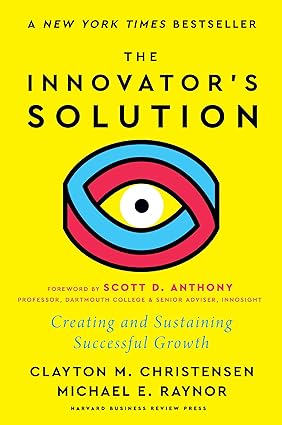The Innovator's Dilemma: When New Technologies Cause Great Firms to Fail & The Innovator's Solution: Creating and Sustaining Successful1 Businesses Through Disruptive Innovation
White Paper
1. Introduction
This white paper explores the seminal work of Clayton Christensen, focusing on his groundbreaking concepts of "The Innovator's Dilemma" and "The Innovator's Solution." These frameworks offer profound insights into the challenges faced by established companies in adapting to disruptive innovation and provide valuable guidance for navigating the complexities of a rapidly evolving business landscape.
2. The Innovator's Dilemma: Understanding the Challenge
- Core Concept: The Innovator's Dilemma describes the predicament faced by successful companies that are driven by a customer-focused approach. While this focus serves them well in their existing markets, it often blinds them to the potential of disruptive technologies that initially appear inferior to their established offerings.
- Key Drivers of the Dilemma:
- Listening to Customers: Established companies prioritize existing customer needs and demands. Disruptive technologies often initially serve non-existent or low-end markets, not the needs of their existing customer base.
- Resource Allocation: Companies allocate resources to projects with the highest expected returns, often favoring incremental improvements to existing products over risky investments in nascent technologies.
- Organizational Culture: Established companies often have ingrained processes and cultures that prioritize efficiency and predictability, making it difficult to embrace the uncertainty and experimentation associated with disruptive innovation.
- Examples:
- The rise of personal computers: Mainframe computer manufacturers, focused on the needs of large corporations, failed to anticipate the disruptive impact of personal computers.
- The disruption of the music industry: Traditional record companies, heavily invested in physical media, were slow to adapt to digital music distribution and streaming services.
3. Disruptive Innovation: A Closer Look
- Defining Disruptive Innovation: Disruptive innovation refers to a process where a new technology enters a market at the bottom, initially offering inferior performance but with other compelling attributes, such as lower cost, greater simplicity, or greater accessibility.
- Two Types of Disruptive Innovation:
- Low-End Disruption: Enters an existing market from the bottom, targeting underserved customers who are not willing or able to pay for existing high-end products.
- New-Market Disruption: Creates a new market by offering a product or service to a segment of consumers who previously lacked access to it.
4. The Innovator's Solution: Overcoming the Dilemma
- Recognizing and Assessing Disruptive Threats:
- Market Research Beyond Existing Customer Base: Actively seek out and understand the needs of emerging markets and underserved customer segments.
- Scenario Planning: Develop and analyze different future scenarios, including those involving disruptive technologies.
- Building "Spin-offs": Create independent organizations or business units to pursue disruptive opportunities without the constraints of the parent company.
- Embracing Experimentation and Flexibility:
- Allocate Resources for "Wild Cards": Invest in high-risk, high-reward projects that may not yield immediate returns.
- Foster a Culture of Innovation and Experimentation: Encourage experimentation, tolerate failure, and reward risk-taking.
- Develop Agile Processes: Adopt flexible and iterative development methodologies that allow for rapid adaptation and course correction.
- Building Sustainable Disruptive Businesses:
- Focus on Customer Value: Define and deliver value to new customer segments, even if it means sacrificing short-term profitability.
- Develop a Sustainable Business Model: Create a viable business model that can scale and generate sustainable profits in the long term.
- Build a Strong Ecosystem: Cultivate partnerships and collaborations with other players in the ecosystem to accelerate growth and create a competitive advantage.
5. Conclusion
The Innovator's Dilemma and The Innovator's Solution provide valuable frameworks for understanding the challenges and opportunities associated with disruptive innovation. By recognizing the signs of disruption, embracing experimentation, and focusing on customer value, companies can navigate the complexities of a rapidly changing world and ensure long-term success.
References
- Christensen, C. M. (1997). The Innovator's Dilemma: When New Technologies Cause Great Firms to Fail. Harvard Business School Press.2
- Christensen, C. M., Raynor, M. E., & McDonald, R. (2015). The Innovator's Solution: Creating and Sustaining Successful Businesses Through Disruptive Innovation. Harvard Business Review Press.
- Christensen, C. M. (1995). Disruptive Technologies: Catching the Wave. Harvard Business Review.
Disclaimer: This white paper is for informational purposes only and should not be considered investment or business advice.
This white paper provides a foundational understanding of the concepts. For a more in-depth analysis, further research and consultation with business and innovation experts are recommended.



